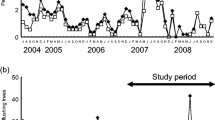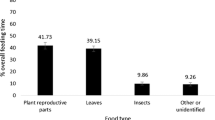Abstract
Food selection in folivorous primates has been hypothesized to be correlated with leaf chemistry. To test this hypothesis, we conducted a 5-month study on Presbytis entellusin a moist deciduous forest in the Rajaji National Park,Uttar Pradesh, India. The study period covered two seasons, winter and spring. We used the percentage time spent feeding on each food item as an index of food selection, which we estimated from group scan data collected from one study group for 6 days each month. We estimated the selection ratio for each item as the ratio of time spent feeding to availability. We estimated food availability from vegetation sampling and phenological data in the home range of the study group. We estimated crude protein (CP), acid detergent fiber (ADF) and tannins in mature and young leaves of 12 major food species in the laboratory. Food selection is positively correlated with CP in winter and negatively correlated with ADF in both seasons. It also is correlated with CPJADF ratio, but to a lesser extent than the best predictor in winter and spring. Selection ratio is not correlated with CP and ADF in both seasons. It is probable that the inclusion of other factors, such as micronutrients,condensed tannins, and digestibility, might give a better prediction of food selection.
Similar content being viewed by others
References
Altmann, J. (1974). Observational study of behavior: Sampling methods.Behaviour 49: 227–267.
Bauchop, T. (1978). Digestion of leaves in vertebrate arboreal folivores. In Montgomery, G. G. (ed.),The Ecology of Arboreal Folivores, Smithsonian Institution, Washington, D.C., 193–204.
Borges, R. M. (1990). Sexual and site differences in calcium consumption by Malabar giant squirrelRatufa indica.Oecologia (Berlin) 85: 80–86.
Borges, R. M. (1992). A nutritional analysis of foraging in the Malabar giant squirrel (Ratufa indica).Biol. J. Linn. Soc. 47: 1–21.
Chopra, S. R., Bhadwar, R. L., and Ghosh, S. (1984).Poisonous Plants of India, Academic, Jaipur.
Davies, G. A., Bennett, E. L., and Waterman, P. G. (1988). Food selection by south-east Asian colobin monkeys (Presbytis rubicunda andPresbytis melalophos) in relation to plant chemistry.Biol. J. Linn. Soc. 34: 33–56.
Freeland, W. J., and Janzen, D. H. (1974). Strategies in herbivory by mammals: The role of plant secondary compounds.Am. Nat. 108: 269–289.
Glander, K. E. (1978). Howling monkey feeding behavior and plant secondary compounds: A study of strategies. In Montgomery, G. G. (ed.),Ecology of Arboreal Folivores, Smithsonian Institution, Washington, D.C., pp. 561–579.
Glander, K. E. (1981). Feeding patterns in mantled howling monkeys. In Kamil, A. C., and Sarguest, T. D. (eds.),Foraging Behavior: Ecological, Ethological and Psychological Approaches, Garland STPM Press, New York, pp. 231–257.
Hagerman, A. E., and Butler, L. G. (1989). Choosing appropriate methods and standards for assaying tannins.J. Chem. Ecol. 15: 1795–1809.
Hiadik, C. M. (1977). A comparative study of the feeding strategies of two sympatric species of leaf monkeys.Presbytis senex andP. entellus. In Clutton-Brock, T. H. (ed.),Primate Ecology, Academic Press, New York, pp. 323–353.
Horwitz, W. (1980).Official Methods of Analysis of the Association of Official Analytical Chemists, 13th ed., AOAC, Washington, D.C.
Jones, W. T., and Mangan, J. L. (1977). Complexes of the condensed tannins of sainfoin (Onobrichis viciflora) with the fraction of leaf protein and submaxillary mucoprotein and their reversal with polyethylene glycol and pH.J. Sci. Food Agr. 28: 126–136.
Kanjilal, U. N. (1979).Forest Flora of the Chakrata, Dehra Dun and Saharanpur Forest Divisions, United Provinces, revised and enlarged edition by Basant Lai Gupta, Bishen Singh Mahendra Pal Singh, Dehra Dun, India.
McKey, D. B., Gartlan, J. S., Waterman, P. G., and Choo, C. M. (1981). Food selection in black colobus (Colobus satanas) in relation to plant chemistry.Biol. J. Linn. Soc. 16: 115–146.
Milton, K. (1979). Factors influencing leaf choice by howler monkeys: A test of some hypotheses of food selection by generalist herbivores.Am. Nat. 114: 362–378.
Mole, S., and Waterman, P. G. (1987). Tannins as antifeedants to mammalian herbivores: Still an open question? In Waller, G. R. (ed.),Allehchemicals: Role in Agriculture and Forestry, American Chemical Society Press, Washington, D.C.
Oates, J. F. (1978). Water plant and soil consumption by guereza monkeys (Colobus guereza): A relationship with minerals and toxins in the diet?Biotropica 10: 241–253.
Oates, J. F., Swain, T., and Zantovska, J. (1977). Secondary compounds and food selection by colobus monkeys,Biochem.System. Ecol. 5: 317–321.
Oates, J. F., Waterman, P. G., and Choo, G. M. (1980). Food selection by the south Indian leaf monkey.Presbytis johnii, in relation to leaf chemistry. Oecologia (Berlin) 45: 45–56.
Rosenthal, G. A., and Janzen, D. H. (1979).Herbivores, Their Interaction with Secondary Plant Metabolites, Academic Press, New York and London.
Trease, G. E., and Evans, W. C. (1977).Pharmacognosy, 11th ed., Bailliere Tindal, London.
Van Soest, P. J. (1963). Use of detergents in analysis of fibrous feeds. II. A rapid method for the determination of fibre and lignin.J. Assoc. Offic. Agr. Chem. 46: 829–835.
Vellayan, S. (1982).Chemistry and Digestibility of Foods of the Lar Gibbon (Hylobates lar), Unpublished M.Sc. thesis, Universiti Pertanian, Malaysia.
Waterman, P. G. (1983). The distribution of secondary metabolites in rain forest plants: Toward an understanding of cause and effect. In Sutton, S. L. Whitmore, T. C., and Chadwick, A. C. (eds.),Tropical Ram Forest: Ecology and Management, Blackwell, Oxford.
Waterman, P. G. (1984). Food acquisition and processing as a function of plant chemistry. In Chivers, D. J., Wood, B. A., and Blisbourgh, A. (eds.),Food Acquisition and Processing in Primates, Plenum Press, New York, pp. 177–211.
Waterman, P. G., and Choo, G. M. (1981). The effects of digestibility reducing compounds in leaves on food selection by some colobines.Malay. Appl. Biol. 10: 147–162.
Watts, D. P. (1991). Ecology of gorillas and its relation to female transfer in mountain gorillas.Int. I PrimatoL 11: 21–46.
Wrangham, R. W., and Waterman, P. G. (1981). Feeding behavior of vervet monkeys onAcacia tortilis andA. xanthophloea, with special reference to reproductive strategies and tannin production.J. Anim. Ecol. 50: 715–731.
Author information
Authors and Affiliations
Rights and permissions
About this article
Cite this article
Kar-Gupta, K., Kumar, A. Leaf chemistry and food selection by common langurs (Presbytis entellus) in Rajaji National Park, Uttar Pradesh, India. Int J Primatol 15, 75–93 (1994). https://doi.org/10.1007/BF02735235
Received:
Revised:
Issue Date:
DOI: https://doi.org/10.1007/BF02735235




